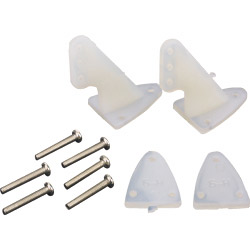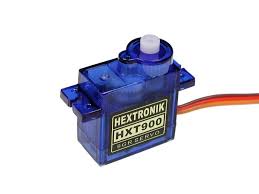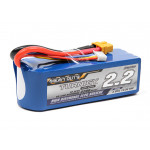
Servos and control horns have a major effect on the way an aircraft will fly. If not set up correctly they will have an adverse effect on the flight and this is something we can avoid. In this article, we discuss how to set up servos and control horns.
I enjoy watching an RC plane that is being flown well by an experienced pilot. So how much is the pilot and the rest setup? In actual fact, it’s a bit both. Not only can an experienced pilot fly well but he can set up a plane so that it will fly well.
Flight Control Surfaces
Aircraft flight control surfaces are aerodynamic devices allowing a pilot to adjust and control the aircraft's flight attitude. It is important that these surfaces move freely without binding or slop and that they return to the same position each and every time. These issues can be fixed fairly easily with a little care and attention.
Common issues include:
- Hinge ceased
- Hinges not aligned correctly
- Control surface binding on the airframe
- Linkage too tight
- Debris caught in linkage
- Loose-fitting control horn
 Hinges can be easily replaced, however, just be sure that the cuts are straight. If the hinges are not straight it will cause binding. Tighten any loose control horn and if necessary re-pack the horn as over time the foam may compress.
Hinges can be easily replaced, however, just be sure that the cuts are straight. If the hinges are not straight it will cause binding. Tighten any loose control horn and if necessary re-pack the horn as over time the foam may compress.
Linkage Systems
Linkage systems are often overlooked and it is one area that can be cause for concern. Check your servo, servo arms, pushrods, and control horns for underrated, loose, or ill-fitting parts. Some manufacturers may include parts that are not quite suitable and this may result in deflection or flutter of control surfaces. Fitting correctly ratted parts are the keys to success and there are no workarounds or shortcuts here. Take the time to install linkages properly and securely so that they are free of slop or play.
Servo arms must travel parallel to the pushrod components, as they are not designed for side forces. Control horns are at their strongest when force is applied this way. A side force may twist or fracture the horn causing an inflight failure. You need to ensure that a servo does not travel more than it needs to as it may overdrive a control surface or cause a horn, hinge to fail. Many radios have the ability to program the servos to travel and this is a perfect situation to configure this feature. In addition to servo travel, we can change the resolution and this can have a similar effect.
Resolution and Travel
By default, most manufacturers use the middle hole in the horn and the servo arm. Whilst this may be fine some planes will benefit from higher-resolution or a more precise control surface. We can make the control much more precise however it comes at the cost of travel. So, this may not be a bad thing if you intended to manually reduce travel in the radio anyhow.
 To increase the resolution or make the control surface more accurate, you will need to move the control rod to the most inside hole on the servo arm and the most outward hole on the horn. This will give us the smallest travel. The reverse will give us the greatest travel and poorest resolution. Move the control rod to the outermost hole in the servo arm and the innermost hole on the control horn. You will notice as you move the servo via the transmitter you can see each servo step and the sensitivity is greatly reduced. So by moving the pushrods around we can dramatically improve the handling of an aircraft.
To increase the resolution or make the control surface more accurate, you will need to move the control rod to the most inside hole on the servo arm and the most outward hole on the horn. This will give us the smallest travel. The reverse will give us the greatest travel and poorest resolution. Move the control rod to the outermost hole in the servo arm and the innermost hole on the control horn. You will notice as you move the servo via the transmitter you can see each servo step and the sensitivity is greatly reduced. So by moving the pushrods around we can dramatically improve the handling of an aircraft.
Control Horns
There is little difference in cost between a poor choice and the best choice for control horns. I prefer nylon or carbon-reinforced plastic horns as they are robust and they will not fatigue easily. Plastic horns may be ok on very small indoor flyers but anything beyond this is unadvisable. There is no reason that nylon could not be used on a little indoor flyer either as there is not a significant difference in cost.
Servo Selection
It is a good idea to select servos that can exert a greater force than what the manufacturer recommends for the aircraft. In addition to force, you need servos that are precise. Flying a plane with poorly centering servos is painful at best. You will never enjoy an aircraft with poorly centering servos. Servos can be reused and in many cases spares sought so do invest in decent servos.
 Many pilots will be familiar with HXT900 servos. It’s no surprise but they are very accurate and reliable. Another excellent servo is the Hobbyking 929MG.
Many pilots will be familiar with HXT900 servos. It’s no surprise but they are very accurate and reliable. Another excellent servo is the Hobbyking 929MG.
So, spending a little extra time setting up the control surfaces with appropriate hardware will give you a better flying aircraft. Mechanical advantage is preferred in place of reducing travel by programming. Choose better servos and upgrade control horns to reduce slop.
Written by gozerian
Hear it First: Join our Mailing List
Sign up to receive new product updates, exclusive discounts, news, and more!






